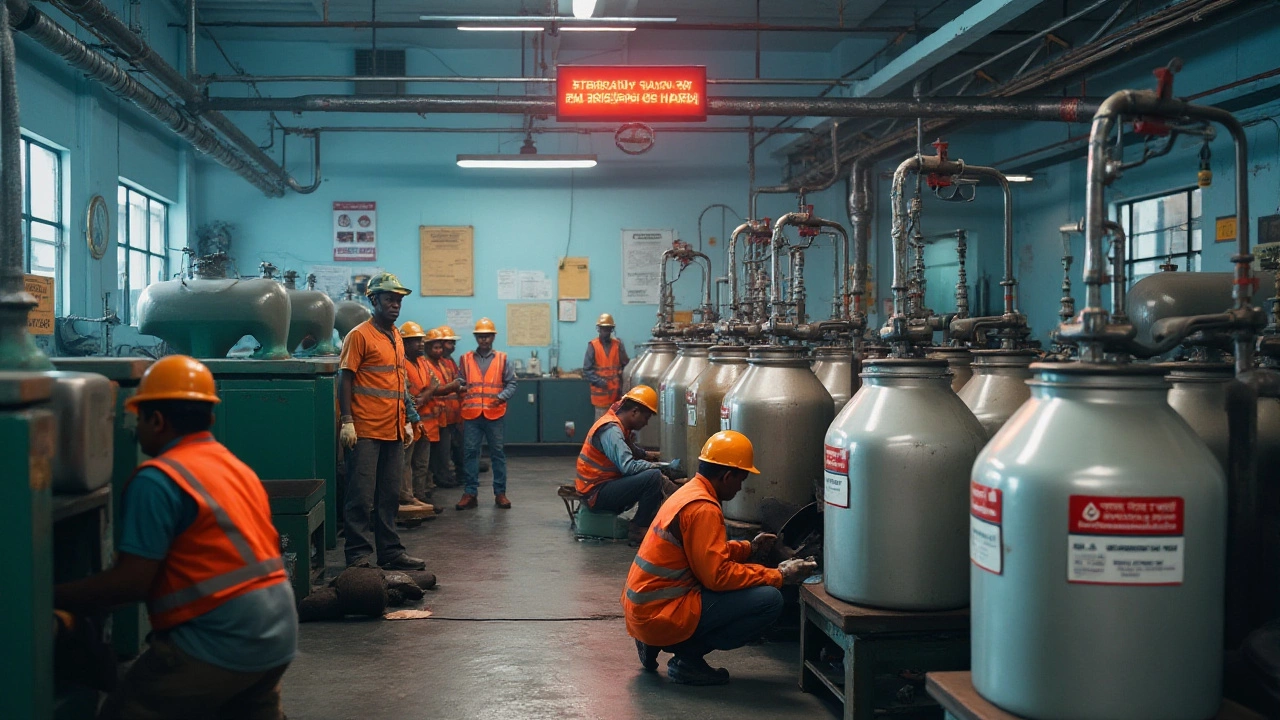Understanding India's Chemical Ban: What You Need to Know

Chemicals play a crucial role in various industries across the globe, and India is no exception. The country's robust chemical manufacturing sector continues to grow and influence global markets. Yet, with this growth comes the responsibility of ensuring that chemical usage does not pose harm to people and the environment. India has implemented bans on specific chemicals to mitigate adverse effects, evaluate associated risks, and promote safer alternatives.
In this article, we take a closer look at India's decisions to ban certain chemicals. We'll uncover the reasons that lead to these prohibitions and explore what impacts these regulations have on manufacturers operating in the region. Whether you're involved in the chemical industry or simply curious about these regulations, understanding them is essential for informed decision-making.
- Overview of Chemical Regulations in India
- Why Certain Chemicals Are Banned
- Impact on Chemical Manufacturers
- Navigating the Indian Market
Overview of Chemical Regulations in India
In India, chemical regulations have undergone a significant transformation over the past few decades. The surge in industrial activities necessitated stringent policies to safeguard both environmental and public health. With one of the largest chemical manufacturing sectors globally, India had to balance industrial needs with safety and sustainability. The Indian government, mainly through the Ministry of Environment, Forest and Climate Change (MoEFCC) and other relevant bodies, established comprehensive laws to monitor and control the use of hazardous substances.
The foundation of chemical regulation in India is laid out by acts such as the Environment (Protection) Act of 1986, which empowers the central government to protect and improve environmental quality. Under this act, the Manufacture, Storage, and Import of Hazardous Chemicals Rules were framed in 1989, providing guidelines to manage and regulate potential hazards. These standards specify requirements for the storage, handling, and disposal of chemicals to prevent accidents and reduce health risks.
A pivotal moment came with the introduction of the Chemical Accidents (Emergency Planning, Preparedness and Response) Rules in 1996. These rules aimed to improve the nation's preparedness to handle chemical emergencies, ensuring rapid response to incidents to minimize harm. Recently, the Indian government has been proactive in updating regulations to reflect changing global standards and technologies. With a rise in chemical imports and exports, India signed treaties like the Stockholm and Rotterdam Conventions, which emphasize the trade of hazardous chemicals and organic pollutants.
India also participates actively in the SAICM (Strategic Approach to International Chemicals Management), which furthers its dedication to the responsible management of chemicals. This commitment is crucial for a country with booming industries that could potentially introduce harmful pollutants. A notable example can be found in India's decision to implement bans on certain substances like asbestos, drawing support from various environmental and healthcare groups. Implementing these bans was not without its controversies, including industrial pushback due to economic implications. However, the step was essential to align with global health and safety norms.
"India's proactive stance on chemical regulation is a testament to its commitment to sustainable industrial development." - Aarti Khosla, Environmental Policy Expert
The Indian chemical industry is governed by an intricate web of laws intended not only to enforce compliance but also to motivate innovation by encouraging safer chemical alternatives. As international corporations seek partnerships in India, understanding these regulations is paramount. The evolving legislative framework indicates a shifting focus towards reducing reliance on harmful chemicals—prioritizing a more sustainable approach, ensuring human and environmental safety remain at the core of industrial production.
Despite these robust regulatory measures, challenges remain. The dynamic nature of the global chemical industry means Indian laws are constantly catching up with international developments. The rise of new pollutants and technological advances requires ongoing updates to policies. Staying informed and compliant can be daunting, yet represents an opportunity for manufacturers to lead in best practices, not just within India, but on the world stage.

Why Certain Chemicals Are Banned
The Indian government has undertaken a careful scrutiny of industrial chemicals used within its borders. These bans are often enacted with an intent to safeguard both public health and the environment from potentially harmful effects. Among the primary reasons for banning certain chemicals in India is their links to significant health issues. Some substances have been directly associated with severe diseases and disorders that impact humans and wildlife. For instance, persistent organic pollutants (POPs) have been known for their longevity in the environment and their ability to bioaccumulate through the food chain, posing a risk to both the ecological system and human health.
Another crucial factor is the environmental impact of these chemicals. Certain substances have been identified as key contributors to environmental degradation, affecting soil and water quality, and leading to issues like habitat destruction and biodiversity loss. For instance, the extensive use of chemicals like endosulfan led to various environmental concerns, resulting in India banning its use in 2011 due to its toxicity and ecological threat. These decisions often stem from scientific studies and public outcry, which help the government shape policies aimed at minimizing potential risks.
Economic factors also play a role in why some chemicals are banned. Bans can protect the country's agricultural and natural resources, ensuring their sustainability for future generations. By eliminating hazardous chemicals, India aims to maintain its crop quality and protect its vast forests and natural landscapes. The aim here is long-term economic stability, which aligns with broader sustainability goals and protects vital sectors of the economy that could be compromised by environmental damage.
The impact of international agreements and practices cannot be ignored either. India, being a party to numerous international treaties such as the Stockholm Convention on Persistent Organic Pollutants, has legal obligations to comply with these international standards. Such adherence not only benefits India by reducing pollution and health risks but also strengthens the country's standing on the global stage.
"Chemicals which are considered safe and effective today may not be so down the line; therefore, vigilance remains key," says Dr. Rajesh Kumar, a respected environmental scientist based in Mumbai.
Public pressure and advocacy from various environmental groups also significantly influence the banning of certain chemicals. As public awareness regarding chemical hazards increases, so does the demand for stricter regulations and safer alternatives. The combined pressure from citizens, NGOs, and other stakeholders often catalyzes legislative action, ensuring that the concerns of the populace are addressed adequately.

Impact on Chemical Manufacturers
The chemical ban India has extensive impacts on companies engaged in the production and distribution of these substances. Facing stringent regulations, many manufacturers must adapt quickly to remain compliant with the new legal framework. These adjustments can involve significant changes to production processes, sourcing of alternative raw materials, and even re-engineering of entire product lines. The financial investment required for these shifts might be considerable, placing a strain on smaller businesses that lack the resources of larger, multinational counterparts.
One critical aspect of navigating these changes is the introduction of safer, sustainable chemical alternatives that align with India's regulatory landscape. Companies are now investing heavily in research and development to discover innovative solutions, driving the industry toward greener practices. As a result, the sector is witnessing a transformation that prioritizes environmental and public health over traditional profit models. This shift reflects a growing global awareness and push for sustainability, which is gradually redefining norms within the chemical industry.
There's an encouraging aspect to these challenges: new opportunities arise for businesses that innovate wisely. By adopting cutting-edge technologies and pioneering eco-friendly chemicals, companies can establish themselves as leaders in an increasingly competitive market. According to a report from the Indian Chemical Council, the rapid response of the industry to regulatory changes can create market avenues worth billions for compliant entities.
"A step toward compliance doesn't just mean survival—it's an investment in the future," notes Dr. Ramesh Patel, a leading industry expert. "Manufacturers who adapt can expect to thrive in a market that favors sustainability and innovation."
It's important for companies to engage with regulatory bodies and participate in discussions around chemical bans, as collaborative efforts often lead to more balanced regulations. Manufacturers keen on maintaining operations in India should remain informed about any potential bans or regulatory updates. They can benefit from industry workshops or seminars focused on regulatory compliance, and joining forces with trade associations like the Indian Chemical Council can be strategic for advocacy and information sharing.
Overall, while the ban on certain chemicals presents hurdles, it can also drive positive change within the industry. Companies that embrace this shift will likely lead the path in making Indian manufacturing chemicals cleaner and safer, contributing to a legacy of responsible and sustainable industrial practices. The future of the chemical industry in India thus hinges upon its ability to balance regulatory compliance with innovative industry practices.

Navigating the Indian Market
Entering the Indian chemical market, especially in light of specific chemical bans, demands strategic planning and an adaptable approach. For manufacturers eyeing the diverse and ever-evolving landscape of India, understanding the regulatory framework is paramount. The government imposes stringent regulations with the intent to safeguard public health and the environment, aiming to curb hazards associated with specific chemicals. With rules that vary by state, keeping abreast of national and regional notifications concerning permissible chemical usage is crucial. This can often involve being a step ahead of future policies, as proactive adaptation may give businesses a competitive edge.
One beneficial strategy for manufacturers is to cultivate strong relationships with local regulatory bodies and industry experts. Establishing this network can prove invaluable, providing insights into upcoming regulations or potential amendments. Being part of professional groups, associations, and forums specific to the Indian manufacturing chemicals sector can not only aid in staying informed but also facilitates sharing best practices within the industry. Furthermore, frequently attending industry conferences and workshops can provide first-hand knowledge from government officials and seasoned professionals alike.
Innovation and adaptability are key components when navigating the Indian chemical domain. Businesses need to assess their product portfolios and determine how to reformulate or substitute banned substances. Investing in research and development to find viable, eco-friendly alternatives can pay dividends in the long run. This approach aligns with the increasing global demand for sustainable and ethically produced products. It's about turning regulatory challenges into opportunities for growth, by using this period of transition to introduce new, compliant products into the market.
Conducting thorough market research is essential to truly understand customer needs and identify emerging trends. Tailoring strategies to cater to these demands will likely facilitate a smoother entry and expansion within the stringent confines of Indian regulations. Price sensitivity, consumer preferences, and technological advancements are factors that companies need to consider while drafting their market strategies. Moreover, leveraging technology could enhance supply chain efficiency and optimize production processes, essentially lowering costs while maintaining compliance.
According to a report released by the Ministry of Chemicals and Fertilizers, India is one of the largest consumers of chemicals globally, driven by its substantial agricultural sector and the burgeoning demand for consumer products. This presents a massive opportunity for foreign entrants who are willing and able to navigate the regulatory landscape.
"Sustained success in the Indian market often hinges on a company's ability to align its offerings with regulatory and cultural expectations," noted a senior analyst in a recent industry conference.
In conclusion, entering and succeeding in India's chemical market under the prevailing regulations is a balanced act of strategic foresight, regulatory compliance, and innovative evolution. Companies that invest in understanding and adapting to the unique needs of the Indian market, all while addressing environmental and health concerns, are likely to not only thrive but set benchmarks in the chemical manufacturing sector.